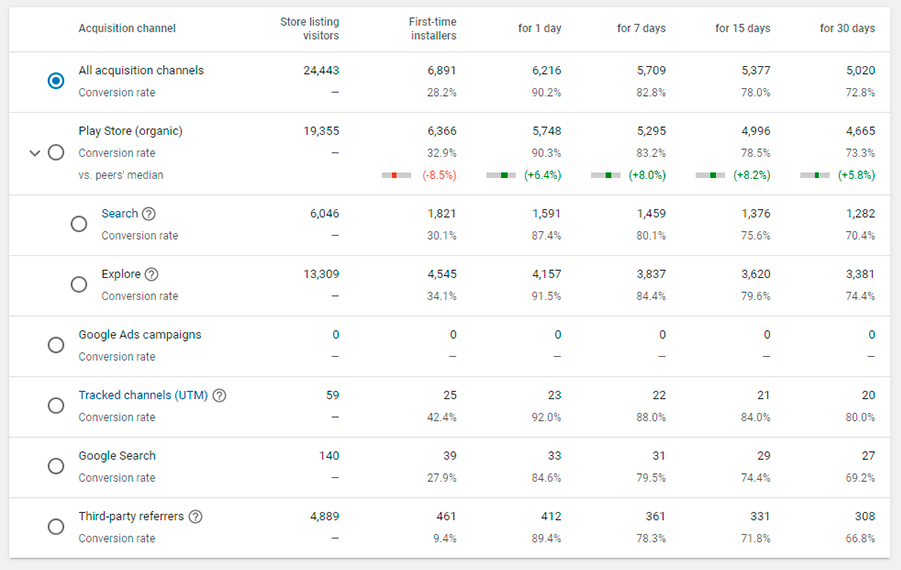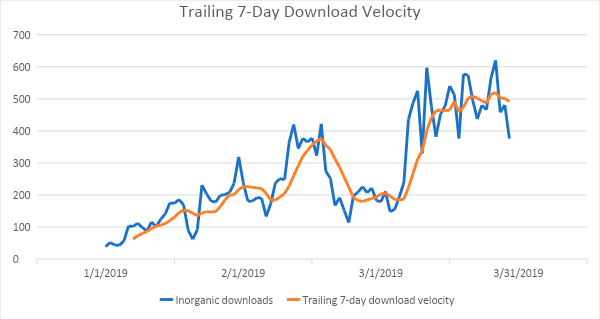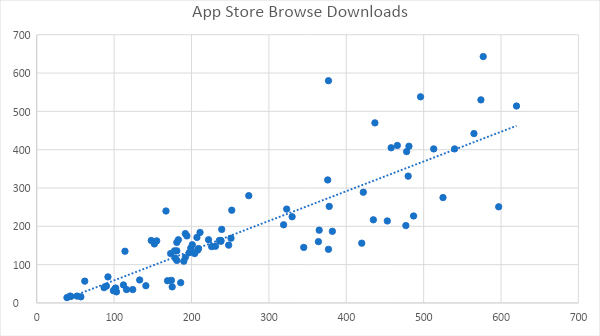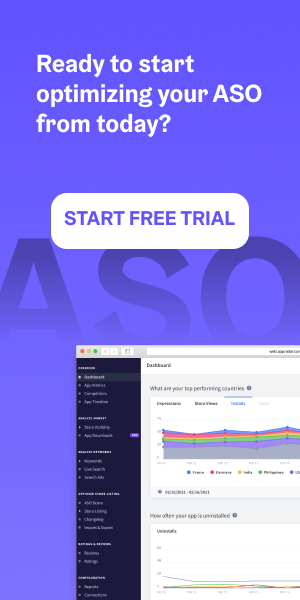In this guest post by our dear friend Gabe we are going to learn how Organic Uplift affects your App Store Optimization strategy.
What is Organic Uplift?
Modern ASO is no longer just SEO for the App Store. This is because modern ASO requires much more collaboration across business units than traditional ASO, from product influence, to user engagement, to Organic Uplift and beyond.
On the topic of Organic Uplift in particular, it’s important to note that it not only has an influence on an app’s top chart ranks, but also an app’s keyword ranks (although to a smaller degree than a direct keyword download), as well as an app’s explore/browse downloads, which is most critical for the direction that app discovery is progressing in the Google Play Store.
Therefore, for modern ASO managers, it is imperative to have a proper understanding of the technical underpinnings of organic uplift, in order to be equipped to make the best strategic decisions on considerations which influence the success of ASO.
Let us begin with establishing a strong, technical definition of Organic Uplift:
Organic Uplift as a working definition refers to “the portion of organic visibility which is influenced by inorganic activity.”
The term organic is defined as activity from the App Store or Play Store, from the search or explore/browse segments (with Apple Search Ads app units removed from App Store search app units).
The term visibility is defined by either impressions or downloads. This is an expansion of the traditional Organic Uplift scope which has focused on downloads only. This is useful to encapsulate the full potential scope of uplift; Organic Uplift increases the number of people who see an app in the store – whether by top chart or search – whereupon it is the individual’s discretion whether or not to download. This means that Organic Uplift has the most direct influence on driving impression-based visibility, with a significant but less direct influence on driving downloads.
On the topic of downloads, there are two key nuances to understand about organic downloads.
First, while MMPs (mobile measurement partners) do measure “organic” downloads, it is important to know that these are typically not all true organic downloads, as the “organic” download bucket in an MMP refers to any non-tracked source of installs (similar to the direct bucket in Google Analytics).
Second, an MMP’s definition of an install or download is different from that of the App Store or Play Store. An MMP will record a first open, while the stores report on a download, which may or may not ultimately lead to an app open.
Moving on, the term inorganic activity is defined as all activity that is not organic. That means impressions, clicks, and downloads sourced from advertising, email, PR, website referrals, etc. – anything that is not store search/explore activity sourced from within the stores.
This is also an expansion from the traditional understanding of Organic Uplift, which focuses only on advertising activity. This is an important distinction because it supports the realization that an uplift coefficient can be applied to not only paid activity but all inorganic activity, such as PR or referrals as well; if these other sources of inorganic are not studied in addition to paid activity, it can cause gaps in the study’s ability to know which factors influence organic activity. It’s also important to know that, while Organic Uplift refers to inorganic-influenced activity, organic activity can influence other types of organic visibility. For instance, a large increase in feature downloads can cause an increase in search or top chart visibility.
How Does Organic Uplift Affect ASO Success?
Now that we have established a technical understanding of the nuances of Organic Uplift, let us proceed into the influence that it has on modern ASO success.
We all know that store algorithms care about presenting users with the most relevant app to download. Yet what we may not fully comprehend is that, while metadata plays an important role in helping algorithms to determine relevance, metadata is ultimately not the most important signal and reaches its end of usefulness for apps that have very similar metadata (e.g. keywords or Play Store tags).
Furthermore, store algorithms also have the benefit of understanding app groups, vectors and competitor relevance, which diminishes the need for algorithms to rely on an app’s direct metadata, and causes them to look more-so at user-sourced data points such as download velocity, conversion rate, ratings/reviews, user retention, and other signals. Of these signals, download velocity serves as the initiation point wherein the other signals serve as a quality-based, course correctors.
This in turn reveals that an ASO manager’s ASO success potential is really capped by their app’s download velocity. Unless they are equipped to factor organic uplift into their ASO strategy (e.g. by interfacing with decision-making on inorganic budget and target-setting), the ASO manager is not doing all they possibly can to raise their ASO success potential.
For instance, if an ASO manager’s organic downloads are currently averaging 4,000 per month with inorganic downloads of 6,000 per month, then the realistic ceiling of organic potential, all things equal, may be 7,500 per month. This is not to say that keyword optimization, localization, A/B testing, ratings prompt optimization and other forms of ASO cannot unlock organic growth; these still matter tremendously and still do convert incremental or even blockbuster organic growth (especially when unlocking new markets through localization or achieving a massive creative win).
Yet managers of modern ASO will ultimately still encounter some form of limitation on how many downloads they can unlock by tackling growth without the support of being able to influence other key factors such as inorganic growth. By increasing the inorganic downloads to 8,000 per month in the above situation, the realistic ceiling of organic potential may increase from 7,500 to 10,000 or more given the additional support in the critical download velocity signal that the algorithms look for. Note that these numbers in this example are not real numbers but meant to be illustrative only.
How is Organic Uplift Calculated?
Calculating Organic Uplift is typically done via regression or other correlation analyses, which focus on studying how the fluctuations of organic visibility influence the fluctuations of inorganic activity while extracting other influential factors such as seasonality, app stability, user retention and more. The outcome of most Organic Uplift studies is a coefficient to describe the degree of influence of the relationship between inorganic activity and organic visibility.
A regression may indicate for instance that the organic download uplift of search downloads from inorganic downloads is between .2 and .35. This means that for every inorganic download an app drives, another .2 to .35 organic downloads has been observed to be earned from store visibility gains through organic keyword searches.
In the above image, the Organic Uplift coefficient for app store browse downloads is calculated as .7757
Organic Uplift is most traditionally studied across all inorganic sources, but in practice may have a different component by source. Facebook ads, for instance, may have an Organic Uplift of .3, while Apple Search Ads may have an uplift of .25.
One reason for this is that store ads (Apple Search Ads and UAC) may produce a negative or drag factor in uplift caused by the cannibalization of organic traffic by store ads. In this case, a user downloads an app via the ad, when they would have downloaded the app organically, and this creates 0 organic uplift.
Also, while uplift can lead to more top chart, non-brand keyword and recommended app list downloads, a good portion of organic uplift is recognized via brand awareness. This can most directly be expressed by brand searches (i.e. more people searching the brand name) but can also be expressed by conversion rate changes (i.e. more people becoming familiar with the brand and clicking/downloading when seeing the app listing).
Knowing that a good portion of Organic Uplift is expressed in brand visibility is important to consider for an ASO manager when setting growth targets. This is because, while there is virtually no limit to the amount of Organic Uplift visibility gain that can be sourced from brand awareness, there is a limit to the non-brand visibility gain of Organic Uplift. At a certain point, there will either be no more non-brand rank spots in the stores to gain, or the marginal cost in terms of download velocity to attain that next rank spot will remain higher than your app marketing investment to surpass.
To conceptualize this, let’s say that an app drives 10,000 downloads in one day and earns reach rank spot #2 for important non-branded keywords, top chart position #2 for the category, and relevant rankings in recommended app lists of #2. To get to the #1 spot may take another 5,000 downloads per day, so adding another 1,000 downloads will provide very little additional non-brand uplift, yet the app may realize an uplift of 200 more downloads from people searching the app’s brand name and downloading organically rather than from an inorganic means.
This is an example that is unlikely to be encountered exactly as such given the number of placements an app is ranking for at any given time but helps to highlight the mechanics of how organic visibility can be constrained or supported by inorganic activity.
To extend the simplified example and the mechanics, recall that myriad factors influence organic visibility beyond metadata and Organic Uplift. If an ASO manager can’t build the case for acquiring another 5,000 downloads inorganically to help unlock organic rank #1, then an alternative option may be to increase conversion rate by another 2 percentage points, which may be enough to unlock the #1 rank organic spots without Organic Uplift (with 2% incremental downloads from all store visibility to boot)! It is important for ASO managers and their stakeholders to realize that the game of ASO is not only optimizing one or another lever in isolation but prioritizing across a series of alternate levers that operate together in a dynamic world of algorithm management, with a set of various opportunity costs.
If a win isn’t feasible from A/B testing, then this may be overcome with enough inorganic support; but if inorganic support is off the table, then a win from A/B testing may be required to grow. Or, if an app’s star rating dips below a certain level, then to grow the same amount had the star rating been flat will necessitate a larger boost from A/B testing gain or inorganic support.
To sum up, Organic Uplift is a concept that modern ASO managers should be well-versed in, so that they can educate their internal stakeholders on the degree to which organic visibility is influenced by activity not traditionally seen as related to the ASO manager’s job. Without being able to articulate this dependency, the broader organization runs the risk of being misinformed and either setting unrealistic goals which can set the ASO manager up to fail, or under-allocating resources, which can restrict the growth potential of the ASO manager’s work.
Leading marketing and business development at mobile marketing consultancy Incipia, Gabe’s marketing methods are a unique blend of curiosity and data-driven thought leadership. Dedicated to constantly evolving Incipia’s marketing techniques, Gabe co-authored the world’s most comprehensive book on Advanced App Store Optimization and has written over 250 posts on mobile marketing.







1 thought on “How Organic Uplift Affects your ASO Strategy”
Great article despite quite difficult used language (for not native)